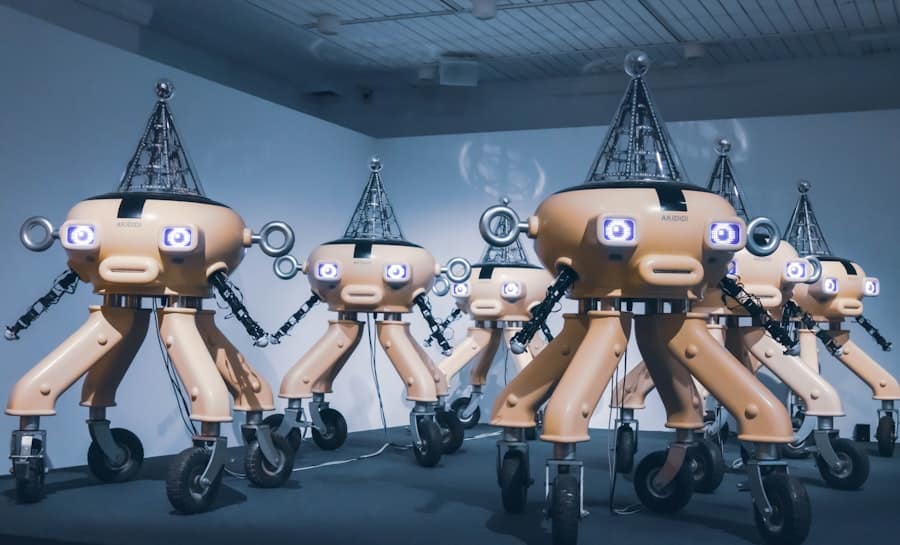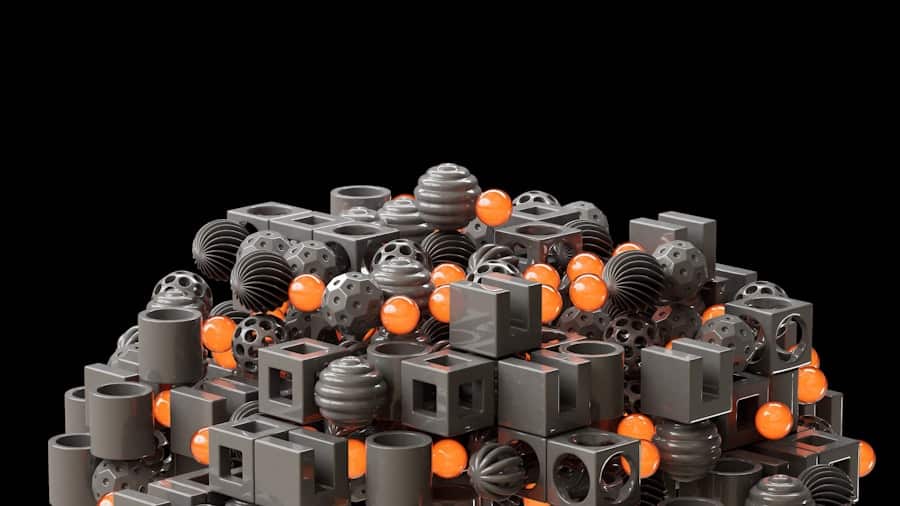Swarm robotics is an innovative field that draws inspiration from the collective behavior observed in nature, particularly among social insects like ants, bees, and termites. These organisms exhibit remarkable capabilities in coordinating their actions to achieve complex tasks, such as foraging for food, building nests, or defending their colonies. By mimicking these natural processes, researchers and engineers have developed robotic systems that can work collaboratively to solve problems that are often too challenging for individual robots.
The essence of swarm robotics lies in the decentralized control of multiple robots, allowing them to communicate and cooperate without a central command structure. This approach not only enhances efficiency but also increases resilience against failures, making swarm robotics a promising solution for various applications. The potential of swarm robotics extends far beyond simple tasks; it encompasses a wide range of fields, including agriculture, search and rescue operations, and environmental cleanup.
As the world grapples with pressing environmental issues such as pollution, climate change, and habitat destruction, the need for innovative solutions has never been more urgent. Swarm robotics offers a unique approach to tackling these challenges by deploying fleets of small, autonomous robots that can operate in unison to perform complex environmental tasks. This article delves into the challenges of environmental cleanup, the mechanics of swarm robotics, its applications in this domain, and the advantages it presents over traditional methods.
Key Takeaways
- Swarm robotics involves the coordination of multiple robots to work together in a decentralized manner, inspired by the collective behavior of social insects.
- Environmental cleanup poses challenges such as hazardous waste removal, oil spill cleanup, and pollution monitoring, which can be addressed using swarm robotics technology.
- Swarm robotics works by enabling individual robots to communicate and collaborate with each other to achieve a common goal, using algorithms for self-organization and decision-making.
- Applications of swarm robotics in environmental cleanup include autonomous monitoring of air and water quality, waste collection and sorting, and precision agriculture for sustainable land management.
- Advantages of using swarm robotics in environmental cleanup include increased efficiency, scalability, adaptability to dynamic environments, and reduced risk to human workers.
Environmental Cleanup Challenges
Environmental cleanup is a multifaceted challenge that encompasses various forms of pollution, including oil spills, plastic waste, hazardous materials, and contaminated soil and water. Each type of pollution presents unique difficulties that require tailored approaches for effective remediation. For instance, oil spills can devastate marine ecosystems, necessitating rapid response efforts to minimize ecological damage.
Traditional cleanup methods often involve manual labor and heavy machinery, which can be inefficient and may inadvertently cause further harm to the environment. Moreover, the scale of many environmental disasters can overwhelm available resources, leading to prolonged recovery times. Plastic pollution is another significant concern that has garnered global attention.
With millions of tons of plastic entering oceans and waterways each year, the challenge lies not only in removing existing waste but also in preventing future accumulation. The sheer volume and distribution of plastic debris make it difficult to address using conventional methods. Additionally, hazardous materials such as heavy metals or chemical spills pose serious health risks to both humans and wildlife.
The complexity of these challenges underscores the need for innovative solutions that can operate effectively in diverse environments and adapt to changing conditions.
How Swarm Robotics Works

At the core of swarm robotics is the principle of decentralized control, which allows individual robots to operate autonomously while still contributing to a collective goal. Each robot in a swarm is equipped with sensors and communication capabilities that enable it to perceive its surroundings and share information with other robots in real-time. This decentralized approach contrasts sharply with traditional robotic systems that rely on a central controller to dictate actions.
In swarm robotics, the focus shifts from individual performance to group dynamics, where the collective behavior emerges from simple rules followed by each robot. The algorithms governing swarm behavior are often inspired by biological models. For example, ant colony optimization algorithms mimic the way ants find food sources by laying down pheromone trails that guide others to the food.
Similarly, flocking behavior observed in birds can inform the movement patterns of robotic swarms. These algorithms allow robots to navigate complex environments, avoid obstacles, and coordinate their actions without explicit instructions.
Applications of Swarm Robotics in Environmental Cleanup
Swarm robotics has shown great promise in various applications related to environmental cleanup. One notable area is oil spill response, where swarms of autonomous drones or underwater robots can be deployed to locate and contain spills quickly. These robots can work together to map the extent of the spill using advanced sensors and imaging technology while simultaneously deploying containment booms or dispersants.
Their ability to cover large areas rapidly enhances response times and minimizes ecological damage. Another application lies in the removal of plastic waste from oceans and waterways. Swarm robotics can facilitate the development of fleets of small surface drones designed to collect floating debris efficiently.
These drones can communicate with one another to optimize their collection routes and avoid overlapping efforts. By working collaboratively, they can significantly increase the amount of waste removed compared to traditional methods that rely on larger vessels or manual labor.
Advantages of Using Swarm Robotics
The advantages of employing swarm robotics for environmental cleanup are manifold. One significant benefit is scalability; swarms can be easily expanded or contracted based on the size and complexity of the task at hand. This flexibility allows for rapid deployment in response to emergencies such as oil spills or hazardous material leaks.
Additionally, because individual robots are relatively inexpensive compared to larger machines or human labor forces, swarm robotics can offer a cost-effective solution for large-scale cleanup operations. Another advantage is resilience; if one robot in a swarm fails or becomes damaged, the remaining robots can continue functioning without significant disruption to the overall mission. This redundancy is crucial in unpredictable environments where conditions may change rapidly or where robots may encounter unforeseen obstacles.
Furthermore, swarm robotics can operate in hazardous conditions that may be unsafe for human workers, such as contaminated sites or disaster-stricken areas. By utilizing autonomous systems in these scenarios, we can protect human lives while still addressing critical environmental issues.
Case Studies of Successful Environmental Cleanup with Swarm Robotics

Several case studies illustrate the successful application of swarm robotics in environmental cleanup efforts. One prominent example is the use of autonomous drones for oil spill response during the Deepwater Horizon disaster in 2010. Researchers deployed a fleet of drones equipped with sensors capable of detecting oil slicks on the water’s surface.
These drones worked collaboratively to map the extent of the spill and identify areas requiring immediate attention. The data collected by the drones enabled response teams to deploy containment measures more effectively and efficiently than traditional methods would have allowed. Another noteworthy case involved a project aimed at cleaning up plastic waste from coastal areas using robotic swarms.
In this initiative, small autonomous boats were designed to navigate shallow waters while collecting floating debris. The boats communicated with one another to optimize their collection patterns and avoid redundancy in their efforts. This project not only demonstrated the feasibility of using swarm robotics for waste removal but also raised awareness about plastic pollution’s impact on marine ecosystems.
Future Developments and Potential for Swarm Robotics in Environmental Cleanup
The future of swarm robotics in environmental cleanup holds immense potential as technology continues to advance. Ongoing research focuses on enhancing communication protocols among robots to improve coordination and efficiency further. Innovations in artificial intelligence and machine learning are also expected to play a crucial role in enabling swarms to adapt dynamically to changing environments and tasks.
For instance, future robotic swarms may be equipped with advanced algorithms that allow them to learn from past experiences and optimize their strategies over time. Moreover, as public awareness of environmental issues grows, there is likely to be increased investment in developing robotic solutions for cleanup efforts. Collaborations between governments, research institutions, and private companies could lead to more comprehensive approaches that integrate swarm robotics with other technologies such as satellite monitoring and data analytics.
This holistic approach could enhance our ability to respond effectively to environmental challenges while fostering sustainable practices.
The Role of Swarm Robotics in Creating a Sustainable Environment
Swarm robotics represents a transformative approach to addressing some of the most pressing environmental challenges we face today. By leveraging the principles of collective behavior observed in nature, these robotic systems offer innovative solutions for tasks ranging from oil spill response to plastic waste removal. The advantages of scalability, resilience, and cost-effectiveness make swarm robotics an attractive option for environmental cleanup efforts.
As we look toward the future, continued advancements in technology will likely expand the capabilities of swarm robotics even further. By integrating these systems into broader environmental management strategies, we can enhance our ability to protect ecosystems and promote sustainability on a global scale. The role of swarm robotics in creating a cleaner, healthier environment is not just a possibility; it is an emerging reality that holds great promise for generations to come.
In recent years, the field of swarm robotics has gained significant attention for its potential in environmental cleanup efforts. These autonomous robotic systems work collaboratively to tackle large-scale environmental challenges, such as oil spills and plastic pollution in oceans. A related article that delves into the technological advancements influencing various sectors, including robotics, is available on ENI Comp’s website. You can explore more about these trends by reading the article titled “Top Trends on YouTube 2023” at this link. This article provides insights into how emerging technologies are shaping industries and could offer a broader context for understanding the role of swarm robotics in environmental applications.
FAQs
What is swarm robotics?
Swarm robotics is a field of robotics that involves the coordination of large numbers of simple robots to accomplish tasks collectively. These robots communicate with each other and work together to achieve a common goal.
How can swarm robotics be used in environmental cleanup?
Swarm robotics can be used in environmental cleanup to efficiently and effectively remove pollutants, debris, and waste from the environment. The robots can work together to cover large areas, identify and collect pollutants, and transport them to a designated location for disposal.
What are the advantages of using swarm robotics for environmental cleanup?
Some advantages of using swarm robotics for environmental cleanup include increased efficiency, flexibility, and scalability. The robots can work in parallel to cover large areas quickly, adapt to changing environmental conditions, and be easily scaled up or down based on the size of the cleanup operation.
What are some examples of swarm robotics being used in environmental cleanup?
Examples of swarm robotics being used in environmental cleanup include the deployment of robot swarms to clean up oil spills, remove plastic waste from oceans, and clear debris from disaster-stricken areas. These applications demonstrate the potential of swarm robotics to address environmental challenges.
What are the challenges of using swarm robotics for environmental cleanup?
Challenges of using swarm robotics for environmental cleanup include the need for robust communication and coordination among the robots, the development of efficient algorithms for task allocation and decision-making, and the integration of sensor technologies for environmental monitoring and pollutant detection. Additionally, ensuring the safety and ethical considerations of using autonomous robots in sensitive environmental areas is also a challenge.

